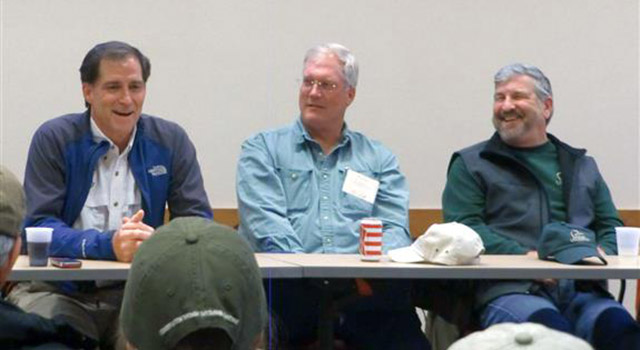Conservation organizations and agencies from across the country have committed to helping balance the needs of wildlife and people with the rapid conversion of wetlands and grasslands in the Prairie Pothole Region. Gathering in Bismarck, N.D. in June 2013, for a “Prairie Summit,” over 90 representatives of public agencies, conservation organizations, and conservation leaders discussed the issues and possible solutions needed to address current loss of wildlife habitat in the Pothole region. (Photo shows the USFWS Director Dan Ashe, The Conservation Fund’s Midwest Region Director Tom Duffus, and Ducks Unlimited CEO Dale Hall discussing issues with participants).
Following the Summit, a list of priority action steps was developed:
- Maintain the 70% allocation of “Duck Stamp” revenue for prairie conservation
- Fully fund the Land and Water Conservation Fund; increase the amount going to Dakota Grasslands Conservation Program
- Increase the federal Duck Stamp price to $25 per year
- Increase state-level conservation funding
- Support recoupling of federal crop insurance with conservation compliance
- Support a national Sodsaver provision
- Increase private organizational commitments to the prairies
- Increase public understanding of benefits of recreational economy and how wetlands benefit flood control, drinking water and carbon storage
Speaking at the summit, Dan Ashe, Director of the U.S. Fish & Wildlife Service, said those in conservation need to exercise leadership to find solutions. “It’s pretty clear (this landscape) can’t provide everything to everybody,” Ashe said. “It produces food and fiber, and now energy for the United States and continues to provide the bounty of waterfowl and wildlife [habitat] that it has provided for thousands of years.”
From another perspective, Rancher Jim Faulstich, South Dakota, similarly expressed concern. He worries the country is headed in a same direction as it was in the‘30s and ‘80s. “Not only did natural resources suffer then, but so did everything connected to agriculture, including the people who lived on the land at the time,” Faulstich said.
To learn more about how to join these conservationists committed to conservation action for the prairies, contact Becky Jones-Mahlum, Ducks Unlimited

